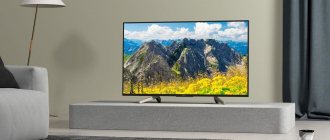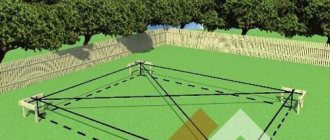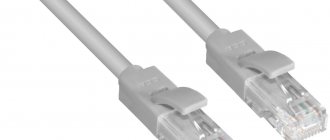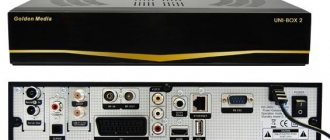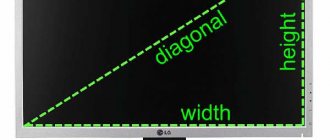Why is the diagonal measured in inches?
When a reasonable question arises, which TV diagonal to choose for optimal and comfortable viewing, not many people think about why it is measured in inches.
There are several versions of the origin of this phenomenon, but the closest to the truth can be considered the option that adherence to the English system of measures is due to the fact that most of the equipment is produced by foreign brands. In the countries where the brand originates, a similar metric system is adopted.
During the existence of the USSR, when domestic televisions were produced, for example, “Beryozka 61TTs-311D”, there was no place for “bourgeois” inches. The number 61 in the name of the model indicated the diagonal, but only expressed in centimeters familiar to Russian people.
In the modern world of electronics, this 61 cm corresponds to 24 inches. This is very little, since they have already learned how to produce PC monitors of a similar size, which does not look large or shocking.
Indicating the diagonal dimensions was necessary, since the standard ratios of the height and width of the TV made it possible, with knowledge of this parameter, to simply calculate the dimensions of the equipment.
Another reason for switching to inches when measuring is basic savings. When recording the diagonal, only one number is used, which indicates the dimensions of the equipment, and not the aspect ratio (height and width), which is more convenient for understanding.
Modern TVs and monitors are increasingly produced in wide format with a 16:9 ratio
Diagonal and grain
Grain is a unit of image, that is, the smallest point on the monitor. This unit directly affects the quality of the picture: the larger the grain, the more convenient it is to read small text, which is especially important for people with poor vision. However, the downside of coarse grain is a rough representation of all other information. That is, pixels are noticeable on smooth lines or high-resolution photographs.
The lower the grain size, the more realistic the picture looks on the monitor screen, but small font suffers. And although this point can be called a double-edged sword, many media content developers are trying to find a certain balance, that is, to correctly display all the information on a fine grain. But in our everyday life there are still a sufficient number of programs where working on a non-fine-grained monitor causes discomfort.
Optimal grain size relative to screen diagonal:
- 0.27-0.30 mm for 18.5-20 inches;
- 0.24-0.25 mm for 21-22 inches;
- 0.265 mm for 23 inches;
- 0.27-0.28 mm for 24 inches;
- 0.31-0.32 mm for 27-28 inches;
- 0.14-0.18 mm for “ultra” monitors.
Many experts, along with buyers, believe that the optimal ratio of diagonal, grain and cost of a monitor is found in 24-inch devices with Full HD resolution. If you wear glasses or have other vision problems, then you should not buy devices with fine or even medium grain, because it will hurt your eyes to look at system fonts or other small details of the content. Of course, you can change the display scale to a larger one, but then the clarity of the picture will greatly suffer and its proportions will be distorted.
The correct ratio of screen height to width
If earlier, at the dawn of the appearance of flat-panel TVs, the size ratio, indicating width and height, was the same for each model, then modern brands demonstrate evolution.
Now you can increasingly see numbers such as 4:3 or 16:9 on packaging or transport film applied to the screen.
To understand what is hidden under these designations, and what relation they have to the question of how to find out the diagonal of a TV, you need to turn to history.
These numbers indicate the aspect ratio of the screen. In the early days of the content reproduction industry, the ratio used was 1:1 or square. This was used exclusively for photography, allowing the frame to be oriented both horizontally and vertically.
This format was then replaced by the 5:4 ratio, which was practically no different from the 4 by 3 ratio that was later common. The essence of this format is that one side of the screen (height) is used as a conventional unit, and the width is tied to it.
The difference between 5:4 and 4:3 lies solely in the resolution of the matrix, but some users felt that the first ratio conveyed geometric shapes better. There is no documentary evidence of this fact; everything is solely based on a subjective assessment.
4:3 is an almost authentic square, which was used at the very beginning of the television era.
For a long time, the 4:3 format has become the official standard for analogue broadcasting. But with the development of digital television and technology, the rules and requirements changed. Nowadays, the 16:9 ratio or widescreen image is increasingly used. It provides the user with the opportunity to get more pleasure from watching a movie by increasing the viewing area.
The interesting thing is that with the same screen diagonal, but different ratios, the overall dimensions of the television receiver will differ. In one case (4:3) it will be more square, and with proportions 16:9 it will become elongated.
Also, an increase in the height-to-width ratio of the sides led to expanded viewing angles.
When deciding to replace a standard TV with a widescreen model while maintaining its proportions, you need to make simple calculations: the screen diagonal must be multiplied by 1.22. For example, when replacing a 40-inch TV, the dimensions of which are 102 cm, with a similar one, you will need to buy a TV with a diagonal of 49 inches, which in centimeters will be 127.
The diagonal is directly related to the physical dimensions of the TV or monitor
Determination methods
Diagonal is the distance from the bottom corner of the TV screen to the opposite top corner. Moreover, the parameter concerns only the matrix, and not the frame, the width and height of which varies among foreign manufacturers.
Inches in cm
However, even an accurate corner-to-corner measurement does not always give a true idea of what the image size will be. Chinese TVs common in Russia sometimes provide it with a black edge around the perimeter. This means that the figure of 109.22 or 109.24 centimeters, obtained by calculation, is a parameter of the size of the TV screen, but not the image obtained for visualization.
An inch is 2.54 centimeters. If you trust the manufacturer, you can simply multiply this figure by the 43 inches indicated in the passport. However, there are buyers for whom not only this parameter matters.
Distance to sofa depending on inches
Living in a small or limited space of small size, they are forced to be interested not only in the size of the image, but also to calculate how many centimeters the length and width are. The ability to place the TV in the space allocated for it often depends on this. The preservation of the potential viewer’s vision is also of no small importance.
Dimensions 43″ TV
In standard, mass-produced versions, the aspect ratio can be 16:10, 16:9 and 4:3. A regular 43″ TV is a general definition that may hide the following parameters in centimeters, shown in the table below.
| Aspect Ratio | Height, in centimeters | Width, cm | Diagonal, cm |
| 16:10 | 57,89 | 92,62 | 109,22 |
| 16:9 | 53,55 | 95,19 | 109,22 |
| 4:3 | 65,53 | 87,38 | 109,22 |
TV sizes depending on diagonal
Modern electronics supermarkets offer many televisions of various sizes. Independently determining the dimensions of equipment in a showroom is not an easy task. Therefore, the required TV sizes should be considered before visiting the store.
The main parameters that are taken into account when determining the optimal size are:
- room area;
- Also, the choice of TV diagonal depends on the distance for comfortable viewing;
- design features.
Since it is difficult to find the dimensions of a TV in centimeters, since all dimensions are presented in English units of length, you should use special tables of TV diagonals in inches and centimeters.
For each type of room, the optimal solution will be its own diagonal
The optimal choice for the type of room would be the following size variations:
- for the kitchen - from 19 to 22 inches;
- in the bedroom you can place a TV with a diagonal of 22 to 26 inches;
- if the TV is planned to be placed in the hall, then its dimensions can range from 32 to 65 inches.
To understand the spread, we can say that a 32-inch TV is 81 cm. And how many cm is in a TV whose diagonal is 43 inches? Answer ? 109. But such models are rare on the market. Manufacturers try to produce even diagonal values.
Why do you measure screen diagonal?
The diagonal of the TV screen is measured in order to determine its size and the distance from the viewer to the screen. If we are talking about a large TV, then from a distance of 2.5-3 meters the screen diagonal can be measured in inches. If the screen size is small, for example, 24 inches, then meters are used.
Why do they measure diagonals and what is it anyway? If you are planning to buy a large TV and do not know which one to buy, then you should know what screen sizes there are.
Usually the following formats are distinguished: 32 inches; 42 inches; 50 inches; 56 inches; 65 inches, 70 inches.
But today the most popular screen size is 75 inches - its diagonal is approximately 1.5 meters, and 100 inches - 1.83 meters. To watch movies, videos and games, you need appropriate screen sizes. It is worth noting that larger TVs are more convenient to use and easier to place on the wall than smaller ones or in a niche. The diagonal of the TV screen is measured using special devices. This makes it possible to accurately determine the dimensions and radius.
There are two ways to measure screen diagonal - the perpendicular ruler method and the visual method:
- The first method is to draw two parallel lines from the edge of the screen to the center of its image. The length of each of them is divided in half, after which the resulting arc is divided further in half. The result is a radius, which is the diagonal of the screen.
- The second method looks like this. A straight line parallel to the screen is drawn in the center of the diagonal ruler. A vertical line is drawn through the center of the diagonal. The middle of the screen is marked along it, and a line parallel to the screen is drawn through this point. As a result, we get the radius - it is equal to the length of the diagonal.
Thus, knowing these two methods, you can choose the size you need, taking into account all the nuances. When measuring screen diagonal it is also worth considering:
- the diagonal of the TV must be larger than the projection size of the window to which the TV is connected;
- For games and watching TV, it is recommended to choose a screen with a large diagonal;
- the larger the screen, the better the image;
- the presence of backlight will increase the number of colors;
- if you plan to keep the TV on the wall, then the diagonal size should be as large as possible for comfortable viewing;
- if the diagonal is small, the TV will be too low, so with this use case you should avoid large diagonals.
Today, most people have TVs at home with screen sizes ranging from 42 to 70 inches. This is due to the fact that this diagonal is considered optimal for watching movies, TV shows and games.
Choosing the optimal TV diagonal is a matter of taste, but it is important to understand that the larger the diagonal, the more wall space and the higher the price. If the area of the room allows, and there are no problems with the placement of furniture, then you can take more.
But you need to keep in mind that this is not only an additional cost for purchasing a TV, but also for purchasing brackets, which can be very expensive.
For example, a TV with a diagonal of less than 42 inches is suitable for the kitchen. Another important factor is the width of the screen, which means the diagonal of the TV. The screen size is mainly determined by its resolution standard.
Widescreen TVs have a larger screen size than regular TVs. If you're looking to buy a 4K TV, you'll likely have to consider TVs with a screen width larger than 108 inches, because current TV broadcast formats don't yet support TVs with that screen size.
Thus, the most popular format is a 4K TV with a diagonal of 50 to 70 inches with Full HD resolution, since it is as close as possible to the 16:9 format.
In terms of resolution, 4K, unlike the lower quality Full HD (the 1920 x 1080 resolution that most TVs use), has very high image quality due to the increase in pixel size.
Distance to TV depending on diagonal
The distance is also determined by the dimensions of the diagonal. To watch TV that has height and width proportions? 4:3, the optimal place would be a sofa located at a distance of 3 to 5 diagonals. For a 16:9 format this figure will be from 2.5 to 3.
What TV diagonal will be optimal for a distance of 3 meters? Based on the above principles, it will be 25 inches.
Another selection criterion based on distance? viewing angles. It is believed that peripheral vision is capable of capturing images ranging from 36 to 40 degrees.
It is also necessary to take into account that some models may have almost invisible frames around the perimeter of the screen, which will make the TV visually smaller.
There is a rule for calculating the distance to the TV, which depends on the diagonal
Rating of the TOP 8 best 28-inch TVs
| Place | Model | Price |
| #1 | Thomson T28RTL5240 28″ (2019) | |
| #2 | LG 28TL520V-PZ 27.5″ (2019) | |
| #3 | Samsung UE28N4500AU 28″ (2020) | |
| #4 | LG 28TL510S-PZ 27.5″ (2019) | |
| #5 | Thomson T28RTE1020 28″ (2017) | |
| #6 | HARPER 28R750T 27.5″ (2019) | |
| #7 | LG 28TK410V-PZ 27.5″ (2018) | |
| #8 | BBK 28LEM-1050/T2C 27.5″ (2018) |
Page navigation:
Conversion calculator cm to inches
On the Internet you can find a large number of calculators designed to convert values. You can use either a universal service to determine the required parameter (for example, from Yandex), or go to specialized sites that tell you about choosing TVs.
There will be a calculator specifically for converting inches to centimeters or vice versa. Also, similar resources offer to find out the actual dimensions of the TV (length and width). For 55 inches, for example, these parameters will be 123 and 72 cm, respectively.
To convert values, you can use a calculator
Varied size
It is not at all difficult to calculate the size of a television or computer monitor in inches. The screen height is multiplied by 2, double the width is added, and the diagonal is measured in the resulting rectangle. But this is not the answer to the question of how many cm the TV occupies, what its overall height is and what parameters it has in length.
Rules and regulations
There is a frame that surrounds the monitor if it is a computer or laptop, and the TV and its screen have a frame provided by the manufacturer. In addition there is a leg. These device accessories also include the concepts of height and width, which the average consumer needs to fit the purchased device, TV or personal computer, into an equipped niche or computer desk.
Sometimes it seems that measuring a monitor diagonally was invented not by well-known electronics brands, but by lazy salespeople. Let's note some points:
- Remembering the distance from one lower corner to the other upper (in this case, the diagonal of the monitor is 24″) is much easier than telling the buyer that the width and length of the device are two specific numbers, and the same parameters of its screen are smaller and equal to two more digital indicators . The same thing would happen when buying a computer or laptop. Otherwise, you can simply call one indicator – 24″ or indicate any other variable value.
- 24″ is a specific device size, usually demanded by homeowners who have large kitchens. In small apartments, it is extremely rare to install a 24-inch TV (monitor) in the kitchen. Equipment with monitors from 19 to 22 inches is more in demand there. It gives a relatively normal view for viewing content, appropriate only in this limited space. The parameter is 19–22 inches, 24″ or more - depends on the footage of the utility room. But if you install such a device in a spacious room in order to see the image from the far corner, such a device is not enough.
Installation height
A personal computer 61 cm diagonally is a relative norm. However, for those who constantly work behind it, sometimes this size is not enough. But how many inches are needed for a laptop monitor to be optimal for the owner is decided depending on the purposes for which it is used.
How to measure the diagonal of a TV
When choosing a TV, many users take measurements incorrectly - they believe that this parameter will be the distance from one corner of the TV to the other.
In fact, there is a simple rule for how the diagonal of a TV is measured. You just need to choose the right starting points. This will be the lower right or left corner and the upper, located diagonally. The matrix is measured directly without external frames.
To select the optimal installation location, you should also measure the depth of the TV. Usually all measurements can be taken with a simple tape measure. But the recent trend for curved screens makes this impossible. A measuring tape will help out here.
The correct diagonal measurement is carried out from the bottom to the top corner only using the matrix
What to look for when choosing?
You should know! When deciding to purchase a small-sized TV, you need to pay attention to the following characteristics:
- Permission. Today, all types reproduce images in HD resolution. This is quite enough for a full viewing. However, if the buyer decides to buy a more expensive model, he will be able to enjoy 4K picture quality.
- Sound. The most acceptable option is 10 W speakers. This sound power is enough to hear the device in a small room. It is worth noting that modern TVs operate without interference or extraneous noise.
- Availability of additional options. These include Smart TV. This feature allows you to watch movies and TV shows online.
- Connectors. USB or HDMI make it possible to connect removable digital media to the device. For example, by downloading your favorite TV series to a flash drive, you can enjoy it all day without advertising. You can stop at any time, then continue watching at the same place.
- Viewing angle. This characteristic allows you to watch your favorite program from any angle, that is, from anywhere in the room. The higher this parameter, the clearer the picture will be, regardless of where you are viewing it.
Screen resolution and its relationship with diagonal
Resolution most often refers to the size of the image that is displayed on the screen. It is counted in pixels. Since resolution is a value that serves to determine the number of elements of a raster image in a certain area, increasing the indicator will lead to a more accurate representation of the original image.
Therefore, in the presence of a large diagonal, an increase in resolution is required so that the picture does not “float”. For the largest televisions, the 4K, or Ultra HD, format was developed, which gives a resolution of ? 3840 by 2160 dpi. Typically, medium-sized TVs use Full HD resolution. Its performance is 1920 by 1080 pixels.
This is enough for the human eye not to distinguish individual pixel grains or matrix elements.
Modern TVs offer high resolution, which ensures clear pictures
The best gaming monitors for a 24-inch computer
24 inches is quite enough for games (primarily for unpretentious gamers). However, for a monitor to be called a gaming monitor, it must have a high refresh rate (144 Hz or higher), decent color gamut, high contrast, plus graphics card technologies. Full HD resolution is quite sufficient, given the diagonal. The monitors listed below have all these advantages, unimportant for work, but critical for gaming.
AOC C24G2AE
It's difficult to achieve an immersive effect on a 24-inch monitor, but AOC engineers made this model curved! Enveloping the user on three sides, this monitor is great for 3D gaming, especially in first person. High-quality 8-bit color reproduction and a refresh rate of up to 160 Hz make this device especially attractive to gamers. In addition, there are separate modes for different types of games (strategies, racing, shooters).
Nice bonuses include built-in speakers (if you don't prefer high-quality audio systems), a VGA port along with DP and HDMI, and VESA support.
Pros:
- Curved shape
- Excellent color rendition
- 165 Hz
- Contrast 3000:1
- Different game modes
Minuses:
- Questionable ergonomics
Samsung C24RG50FQI
A twenty-four-inch curved monitor from Samsung - the undisputed leader in everything related to screens - claims to win in the "style" category. Curved, frameless, with an aggressively shaped stand, it is also equipped with a VA matrix. At Full HD resolution, it offers contrast ratios of up to 3000:1, a 4ms refresh rate, and very rich, rich colors.
The stand is quite ergonomic, which is especially important in the absence of VESA. Other additional functions are also missing, but this allowed the monitor to be released for sale at an attractive price for its class.
Pros:
- High refresh rate and contrast
- Ergonomic
- All imaginable picture enhancement technologies
- VA matrix
- Nice price
Minuses:
- Not the fastest response
- No VESA
ASUS TUF Gaming VG249Q
The Asus 24-inch gaming monitor has everything it needs to be an all-around genre star. Having abandoned the curved screen, the engineers instead introduced support for portrait mode, making the device more versatile. The matrix has a standard Full HD resolution, with a refresh rate of 144 Hz, a response time of 5 ms (not so small, except by gaming standards...), as well as two DisplayPort connectors through which this magnificence becomes available.
Universal positioning gives meaning to built-in speakers. Contrast and maximum brightness seem low, but in practice they are quite sufficient. But 6-bit color looks like an unfortunate compromise - however, this is the most serious drawback.
Pros:
- High-quality matrix with excellent gaming functions
- Universal
- High refresh rate
- Modern set of ports
- Great default color setting
Minuses:
- Not the highest contrast
- Response seems slow
- 6-bit color
Acer VG242YPbmiipx
The more advanced twenty-four-inch Acer monitor will delight gamers with a refresh rate of 165 Hz at Full HD resolution. The matte finish and picture enhancement technologies reduce eye strain and provide excellent viewing angles. Although the color on the monitor is “only” 6-bit, the color rendition is quite good and expressive.
The not very convenient stand is compensated by the presence of VESA. Built-in speakers are a nice bonus. But the DisplayPort cable included would be nice, but alas, there is only HDMI.
Pros:
- Good color rendering
- VESA
- Various “improvers” of pictures
- Built-in acoustics
- Excellent viewing angles
Minuses:
- 6-bit color
- Non-adjustable height
- No DisplayPort cable included
BenQ ZOWIE XL2411P
If you need a versatile 24-inch monitor that is equally suitable for gaming and work, pay attention to this model. The flat screen can be rotated vertically, which makes the monitor convenient for working with documents or portrait photos. The most interesting thing is that a TN matrix is used here. However, at the current level, the picture on it is quite juicy, and the viewing angles are decent.
Full HD resolution and a refresh rate of 144 Hz, combined with a brightness reserve of 350 cd/m², are an excellent set of parameters for gaming. Plus, an adjustable stand and a set of DP, HDMI and DVI ports allow you to use the monitor with both new and quite old PCs.
Pros:
- 144Hz refresh rate
- Portrait mode
- Necessary cables included
- Fast response
- Good brightness reserve
Minuses:
- Failed to set default colors
- Minus
ASUS ROG Strix XG248Q
The main advantage of this 24” monitor – the refresh rate is a fantastic 240 Hz – will only be revealed with a good video card. In addition to the standard features of a gaming monitor (fast response, rich color reproduction, synchronization technologies with a video card), the ROG Strix XG248Q has adaptive backlighting that will enhance immersion in the game.
This monitor is also based on a TN matrix, but of a higher class. The brightness reserve is an impressive 400 cd/m². In addition to the highly customizable stand, the monitor is VESA enabled. The only reason to think before purchasing it is the price, which matches its premium features.
Pros:
- 240 Hz
- Excellent brightness reserve
- Adaptive backlight
- Functional stand plus VESA
- Impressive design
Minuses:
- Impressive price
MSI Optix MAG241CP
As can be seen from the curved screen, this model is a representative of 24-inch gaming monitors. The futuristic design hides everything gamers need: Full HD resolution and 144 Hz refresh rate, 1 ms response time and luxurious color gamut. One of the key features is support for applications for Windows and mobile devices, with which the picture can be very finely adjusted, as well as proprietary Mystic Light backlighting. The matrix is made using VA technology, which combines fast response and rich colors with a contrast ratio of 3000:1.
There are no built-in speakers, but there is a USB hub. The ports include two HDMI and one DisplayPort; Unfortunately, there is no DP cable included. But this is offset by a more than reasonable cost.
Pros:
- VA matrix
- Excellent contrast and color rendition
- Branded lighting
- Fine settings
- Reasonable price
Minuses:
- Low-functional stand
HP 24x
By using a TN matrix in this 24” gaming monitor, its creators used the advantages of the class and successfully compensated for the disadvantages. Here we see an honest 1ms response time and a 144Hz refresh rate. Although the contrast ratio is a modest 700:1, it's not noticeable in most cases. Plus, you can fine-tune its position thanks to the functional stand or install it on a bracket.
The connectors here are modest: one HDMI and one DP. There are no speakers or USB hub. On the other hand, such modesty allowed us to keep the price at a decent level.
Pros:
- Good picture
- High responsiveness
- Great stand
- Affordable price
Minuses:
- Only two video inputs
- Low contrast
LG 24GL650
The 24” gaming monitor from the Korean company is also based on a TN matrix, and again uses all the advantages of the technology. The resolution here is standard – Full HD, with a supported refresh rate of 144 Hz. The matrix responds in 1 ms. Note that this device has a fairly standard contrast ratio of 1000:1. Gamers will appreciate the variety of modes suitable for games of different genres.
The versatility of the solution is emphasized not only by the flat screen, but also by a stand with height adjustment and support for portrait mode. The matte finish will allow you to play and work comfortably. There is a DP cable included, but no HDMI cable.
Pros:
- 144 Hz
- Fast response
- Image enhancement technologies
- Reasonable cost
Minuses:
- Colors must be adjusted manually for the best picture
- The stand takes up a lot of space
DELL S2421HGF
With all the standard features of a 24-inch gaming monitor, this model has unusual design features. For example, ventilation holes with increased efficiency - this is important when used in gaming mode. Otherwise, everything is similar to the slightly higher models: flat TN matrix, Full HD, 144 Hz, contrast 1000:1, brightness 350 cd/m².
The device comes with only an HDMI cable – DisplayPort is not included. But the stand allows you to adjust both the tilt and height, and if you wish, you can install the monitor on a bracket.
Pros:
- Fast Matrix
- 144 Hz
- Sophisticated ventilation system
- Various game modes
- Fine-tuning the position
Minuses:
- Typical color rendering of TN matrices
- No DP cable included
Table of TV diagonals in inches and centimeters
The most common screen diagonals of modern TV receivers, indicating the actual sizes in both units, are presented in the table:
| Inch | Centimeter | Possible resolution |
| 19 | 48 | 1280 by 720 or 1366 by 768 |
| 22 | 55 | 1366 by 768 or 1920 by 1080 |
| 26 | 66 | |
| 32 | 81 | |
| 37 | 93 | 1920 by 1080 |
| 40 | 101 | 1920 by 1080 or 3840 by 2160 |
| 42 | 116 | |
| 50 | 127 | |
| 52 | 132 | |
| 55 | 139 | |
| 58 | 147 | |
| 65 | 165 | |
| 75 | 190 | |
| 85 | 215 | 3840 by 2160 or 7680 by 4320 |
How to choose a diagonal size
The choice of TV diagonal is influenced by two factors:
- distance from which you will watch the television receiver;
- resolution of the picture played on the screen.
And this picture resolution depends both on the screen of the device you purchased, and on the video signal supplied to the TV input.
In the picture you see how to measure the diagonal of a TV.
You can check this yourself when choosing a TV receiver. If you look closely at a low-quality picture, for example, terrestrial television, you will notice all the shortcomings of both the image and the video signal processing circuits. And if you step back a little, minor errors will become invisible.
For example, if we take a television receiver with a diagonal of 32 inches, then for a signal with 625 lines (terrestrial television) the distance to the screen will be approximately three diagonals 32x3=96 inches or 96x2.54=243 centimeters, which is approximately equal to 2.5 meters. And if the image resolution corresponds to 720p, then the distance to the screen for normal viewing will be already 1.9 meters or more. If the TV is already Full-HD, then it will be convenient to view the video image from a distance of 1.3 meters or more. These turned out to be the minimum distances to the screen, when viewed from which distortions caused by the structure of the video signal will not be visible in the picture.
For example, if your viewing distance is approximately 2.2 meters, then when buying an HD Ready TV, you can choose a device with a diagonal of up to 37 inches. If you choose a Full-HD TV, you can increase the diagonal to 52 inches without compromising picture quality. And new models with 4K resolution (Ultra HD), which have a video conversion module to UHD resolution, will already be more than 60 inches at this viewing distance.
For example, one of these TVs: Samsung UE-65NU7400.
Diagonal 65 inches, 4K resolution, there is an upscaling module that increases the resolution of any video to 4K.
UE-65NU7400
But when viewing from a distance that exceeds the calculated distance, a big difference between TVs with different resolutions will not be visible. Do not forget that the resolution of the device itself must match the video signal for the highest quality playback. Therefore, when today almost all TVs are Full HD and even models with Ultra HD resolution appear (4 times higher than Full HD), then the number of pixels in the video signal must be taken into account.
Terrestrial television currently has SD resolution (625 lines). But digital television is becoming more and more widespread, and there the resolution needs to be determined additionally, but it will be higher than SD. There are many films with Full HD quality, but there is still very little Ultra HD content. We can advise you to carry out all calculations today on the condition that you are viewing a video with Full HD quality, and you will receive a minimum viewing distance. And if you need to increase the distance, for example, installing a TV in the living room, then you will not see any damage to the picture quality.
Popular 32" devices
Imagine that you see a 32-inch screen in front of you; how many centimeters would you give him per eye? Mentally double the value given in inches, and then add another half of the original value to it. Now you can clearly see that 32 inches in centimeters is 81.28 cm. To simplify things, you can round up the numbers and say that 32″ corresponds to a value of 80 cm.
Samsung UE32M5503AU
A worthy model that offers the ability to visually upgrade a low-quality image to the Full HD TV standard.
The TV is not very bright, but the special Ultra Clean View technology smoothes out noise. This adds to the viewing pleasure. The device belongs to a number of models that support Smart TV and has built-in Wi-Fi.
LG 32LJ594U
Smart TV with Wi-Fi and a decent resolution of 1366x768.
The manufacturer provides an improved interface and a special button on the remote control to access the ivi media content library. The small size of the TV does not detract from its quality characteristics.


